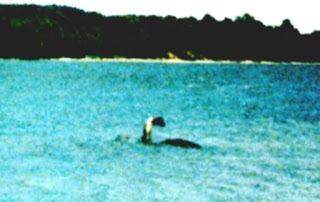Champ is a Plesiosaur
For centuries there have been thousands of reports, rumors and sightings of a mysterious unidentified animal lurking in Lake Champlain on the border between New York and Vermont in the United States. This animal is popularly known as 'Champ'. Yet I have come to believe that there is an explanation for the existence of such an animal. The strange animal in Lake Champlain is a Prehistoric Reptile called the Plesiosaur.
Lake Champlain was formed over ten thousand years ago when an inlet of the Atlantic Ocean, the Champlain Sea was transformed by receding glaciers into an inland freshwater body. Today it is located mainly within the borders of Vermont and New York in the United States but also partially situated across the Canada-United States Border in the Canadian Province of Quebec. It covers more than 400 square miles and is mainly used for ferrying, fishing and small cruises. But there is something in the lake that is unexplainable, well almost.

Map of Lake Champlain
The first recorded sighting of a strange animal in Lake Champlain dates all the way back to 1609 when it is said, the lake’s Namesake, French cartographer Samuel De Champlain came across the lake and its area that was lush, remote and sparsely populated. Champlain is said to be the first European to sight a strange animal in the lake which he described as a “20-foot serpent as thick as a barrel and with a head like a horse”. He was not the first person to see such an animal in the lake, nor the last.
Samuel De Champlain
There are many versions as to how Champlain saw the animal. Some say that he saw Champ while sailing out on the lake, some say from shore though the most plausible is that he saw the lake’s strange resident during the Native American wars between the Iroquois and the Algonquian Tribes which he partook in. While we cannot be certain as to how he saw what he saw, we can say this was only the beginning.
Since 1609, more than 50 people claim to have seen a strange animal lurking in Lake Champlain. Sightings became popular in the 1870s and 1880s. One of the most popular sightings dates to 1870 when passengers of a ferry called the Curlew claimed to have seen Lake Champlain’s strange Animal North of Crown Point, New York. Sighting go even further back as far as 1819 when a steamer captain Crum reported seeing an enormous serpentine animal at least two hundred yards away from him. In 1883, Sheriff Nathan H. Mooney claimed to have seen a serpent-like animal 20 rods from where he was on the shore of the lake. The sightings attracted the attention of politician, businessman and showman Phineas Taylor Barnum who offered rewards in 1873 and 1887 to anyone who could bring him the animal.
In 1870, Lake Champlain's strange animal was seen by the passengers and crew of the Curlew
Champ has been said at times to show a more terrifying or fearless demeanour. In 1873, the first year that Barnum offered a reward for the animal's capture, there was an report of the animal having eyed three young cows drinking at the lakeside, one of whom was later snatched by the beast. During the 1880s, there were even reports of the Champlain Monster having rammed boats and in 1899 there was an account told of the animal on shore although no-one was hurt or drowned fortunately and even to this day no one has died as a result of Champ.
I n 1873, the strange animal of Lake Champlain was reported to have snatched a young cow
However the most famous sighting of the Lake Champlain Monster which occurred in 1977 also produced a photograph (see above page). It was taken by local resident Sandra Mansi who along with her fiancé Anthony and along with Sandra’s two children, 11-year old Heidi-Jo and 12-year old Larry (from her previous marriage), were taking a leisurely drive along Lake Champlain. They drove by some farmland and, around noon, found themselves at a secluded shore of the lake north of Saint Albans. The children went down to the water while Anthony returned to their car to get a camera and his sunglasses. As Sandra watched her children and looked out onto the lake, she noticed a disturbance in the water about 150 feet away. She thought at first it was a school of fish, then possibly a scuba diver. A large head and neck then broke the surface and still Sandra was not scared but still trying to figure out what she was seeing as she found what she was looking at quite majestic comparing it to an eel and an animal that should have been extinct many years ago. When Anthony saw what his fiancé saw he panicked but to not cause anymore panic he and his wife simply told their children that it was lunchtime and that they were going for a pizza which was enough to bring the children away from the lakeside and back to the car. Sandra managed to take one shot before her husband told her to get back into the car and they drove off. The picture was not published until 1979 and it provides the best possible evidence that a large animal exists in Lake Champlain. So famous has Champ become that he has even become part of the Popular Culture of Vermont, from sports teams to advertising. Since the 1970s up until the 1990s, hundreds of investigations have been made in an attempt to prove Champ’s existence and people from all over the world come to Lake Champlain in the hopes of glimpsing its famous resident. He has even been protected by law and hunting him is considered taboo.

Sandra Mansi posing with her iconic photogtaph of Lake Champlain's strange animal
Now even before Samuel De Champlain arrived at the lake that would bear his name, Native Americans living near the shore of the lake always told stories of a mysterious serpent that resided in the lake. They would make offerings to this animal before attempting to cross the lake so that they had a safe passage. The Abenaki Tribe referred to this Animal by many a name but the most common one was ‘Tatoskok’ meaning big serpent. They told Champlain many stories about this animal before and after he made his sighting. But could Native American myths about a strange animal in the lake be responsible for creating a monster in the lake in people’s minds? Or could their stories predate Champlain’s sightings and be original early references to Champ? Neither can be sure.
Statue
of Samuel De Champlain and Native American guide near Lake Champlain
To logically explain the existence of an unidentified animal in Lake Champlain, we should look at two warm-blooded candidates, mammals and birds. Diving or swimming birds such as Swans with their bodies partly submerged would provide the shape of a seemingly Reptilian head.
Tundra Swan
When Otters dive, their tails can also create a similar effect and when they swim in a line, their bodies suggest a hump-like shape similar to that of Champ.
American
Otter
American Eel
The other likely explanation for the Lake Champlain Monster is the
garfish. Samuel De Champlain’s sighting of Champ has often been questioned and
thought to have been misquoted as it has been taken to be more that of fish he
described as being monstrous with snouts and a double row of very sharp
dangerous teeth and near-impenetrable scales that the natives call 'Chaousarou'. This description certainly fits
that of a Garfish or even a large sturgeon (which the Garfish is related to) although this does not rule out the fact that Champlain did see an animal he could not explain at least in the neighbouring Saint Lawrence River which flows into the lake that bears his name
Garfish
If no animal living today fits the description of Champ, we also need to
consider Animals from the dawn of life as explanations for Champ. There are two
Prehistoric Candidates. One is a Reptile from the time of the Dinosaurs called
the Plesiosaur and the other is a Whale that lived during the Ice Age known as
the Zeuglodon or Basilosaurus. The Basilosaurus fits serpentine descriptions
of Champ based on sightings due to a flexible humped body as well as ecolocation that has been reported in the lake and was believed by the late biologist Roy Mackal (1925-2013) to be the best candidate for Champ. However this animal does not
explain the long-necked reports on the lake so our focus should mainly go to
the Plesiosaur whom Champ is said to resemble more.
The
Plesiosaur (right) and the Zeuglodon (left) both which are thought to have been
extinct for 60 million years are the leading candidates put forth to explain Lake
Champlain’s strange animal
Plesiosaur
statue at Crystal Palace Park in London
To support this theory, many Animals from a million years ago are still with us today. A famous example of this is the Coelacanth, a Fish thought to have died out many years ago and was also alive during the time of the Dinosaurs. This species was rediscovered in the 1930s off the coast of Africa. If the Coelacanth survived, what about other Prehistoric Animals? Could a colony of Plesiosaurs be living in Lake Champlain? As far as I am concerned yes, there is a thriving population of these Animals in the lake.
Coelacanth
I now end this by telling all of you who believe in Champ that if you are unsure about what he is, remember that he is a Plesiosaur who has survived the extinction of the Dinosaurs and that there may be many more of his kind living with him in the Lake. I have not yet been to Vermont or Lake Champlain but I hope that if there is indeed a Plesiosaur or a colony of them, then they will be left in peace to enjoy the calm waters of their beautiful habitat. If you are interested more in Champ, feel free to check out these books

















Comments
Post a Comment